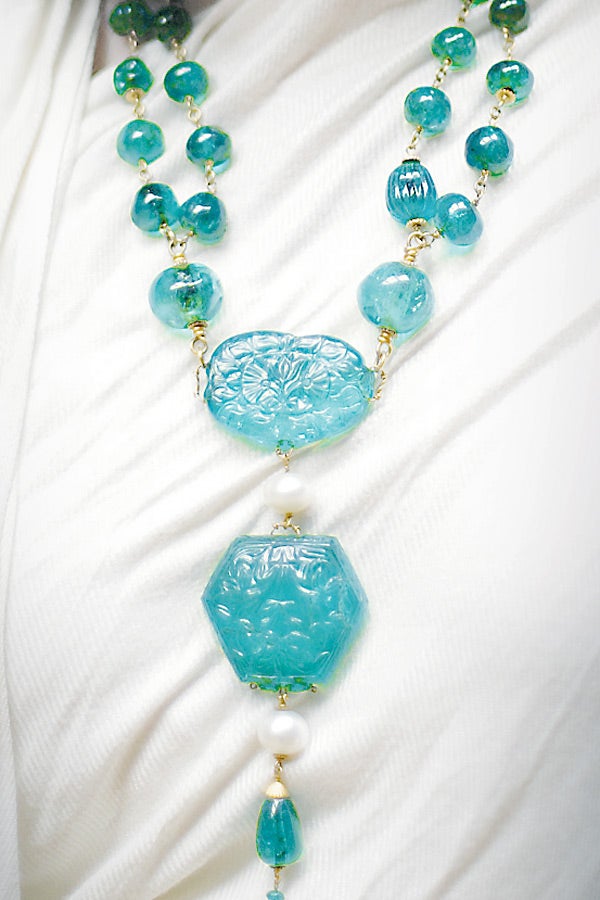Going for £1.6m, the cricketing maharaja's emerald necklace

Your support helps us to tell the story
From reproductive rights to climate change to Big Tech, The Independent is on the ground when the story is developing. Whether it's investigating the financials of Elon Musk's pro-Trump PAC or producing our latest documentary, 'The A Word', which shines a light on the American women fighting for reproductive rights, we know how important it is to parse out the facts from the messaging.
At such a critical moment in US history, we need reporters on the ground. Your donation allows us to keep sending journalists to speak to both sides of the story.
The Independent is trusted by Americans across the entire political spectrum. And unlike many other quality news outlets, we choose not to lock Americans out of our reporting and analysis with paywalls. We believe quality journalism should be available to everyone, paid for by those who can afford it.
Your support makes all the difference.In Britain, it was his sporting prowess that captured headlines from the moment he started scoring runs at Cambridge through his captaincy of Sussex and his appearances for England. He was, they said, "the black prince of cricketers". At home, his 26-year period as ruler of a small state in Gujarat was noted for advanced thinking on the economy and on education.
A potent symbol of his power and authority was a dazzling emerald and pearl necklace which had been a family treasure for centuries. One of the most important historic pieces of Indian jewellery in existence, it was a particular favourite of the maharaja. But now it is for sale with an estimate of £1.6m. The piece will be a highlight of an auction at Christie's, London, on 23 September, with a carriage, manuscripts and other jewels illustrating the wealth and the eye for beauty in India.
The two most important jewels in the Maharaja Jamsahib of Nawanagar's necklace are a 17th-century central oblong emerald estimated to weigh 155cts and an 18th-century hexagonal emerald estimated to weigh 200cts.
David Warren, the director of Christie's jewellery department, said he had seen many carved emeralds but they were nearly always unmounted. "It's very uncommon to find a complete necklace," he said. "I've never actually seen another complete maharaja necklace like this."
The maharaja was born in India in 1872 but studied at Trinity College, Cambridge, where he began his career as a world-class cricketer. He was the first person to score 3,000 runs in a season and two centuries in a day. After university, he became a stalwart for the Sussex county side, which he captained from 1899 to 1903, as well as for England. He scored 72 centuries during his career and is mentioned favourably in comparison with cricketing greats such as the Australian Don Bradman. The most important first-class cricket tournament in India is the Ranji Trophy, a shortened version of his name.
But despite his love of England and the thwack of wood on willow, he also did much for Nawanagar, a state on the Kathiawar peninsula, which he ruled from 1907. He improved the administration and developed the economy, extended the railway, constructed a modern port and electrified its main city. He also introduced free primary education in 1911 and followed with secondary level six years later.
He served in the First World War and represented India at the League of Nations, the United Nations' doomed predecessor, in Geneva. He never married so his throne passed to a nephew when he died in 1933.
Mr Warren said a photograph of him wearing a necklace shows it was not always exactly as it has survived today although it is substantially the same piece. It was not unusual for men to wear such items, he added.
"The men wore the most important jewellery. Their womenfolk had far inferior pieces. They wore them as symbols of status and power. They would wear seven or eight diamond necklaces around their neck and brooches and bracelets and huge turban ornaments and encrust-ed swords."
The maharaja was a connoisseur of jewellery and became a friend of Jacques Cartier, the jeweller. It is thought Cartier himself restrung the necklace. Records show the large hexagon emerald was added in the 1920s or 1930s. It is not known when the piece left the maharaja's family. "When the maharajas became redundant, so did their jewellery," Mr Warren said.
A couple of years ago, an item of turban decoration some 20 or 24ins long and 6ins high, covered in diamonds and dripping with emerald drops came up for sale. It was bought for a woman who turned it upside down and wore it as a necklace. "Women can wear anything, quite frankly," he said. "It's a man's necklace but there are plenty of women who could get away with it."
Join our commenting forum
Join thought-provoking conversations, follow other Independent readers and see their replies
Comments